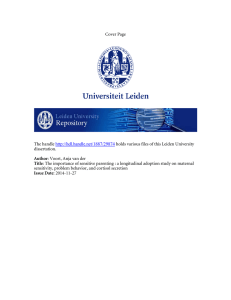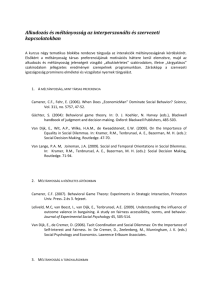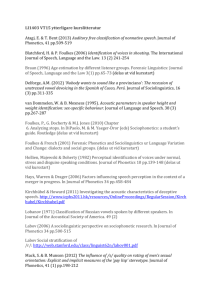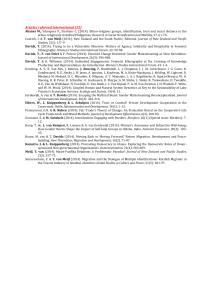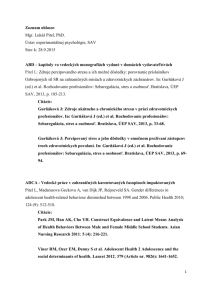disorganized attachment and developmental psychopathology
advertisement
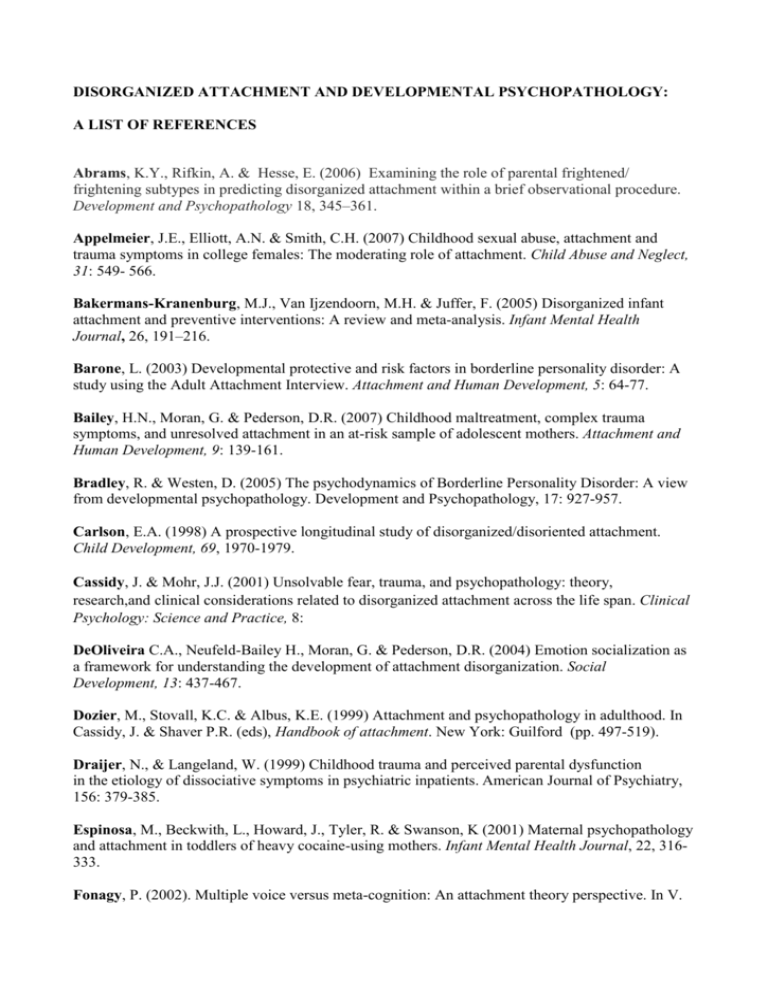
DISORGANIZED ATTACHMENT AND DEVELOPMENTAL PSYCHOPATHOLOGY: A LIST OF REFERENCES Abrams, K.Y., Rifkin, A. & Hesse, E. (2006) Examining the role of parental frightened/ frightening subtypes in predicting disorganized attachment within a brief observational procedure. Development and Psychopathology 18, 345–361. Appelmeier, J.E., Elliott, A.N. & Smith, C.H. (2007) Childhood sexual abuse, attachment and trauma symptoms in college females: The moderating role of attachment. Child Abuse and Neglect, 31: 549- 566. Bakermans-Kranenburg, M.J., Van Ijzendoorn, M.H. & Juffer, F. (2005) Disorganized infant attachment and preventive interventions: A review and meta-analysis. Infant Mental Health Journal, 26, 191–216. Barone, L. (2003) Developmental protective and risk factors in borderline personality disorder: A study using the Adult Attachment Interview. Attachment and Human Development, 5: 64-77. Bailey, H.N., Moran, G. & Pederson, D.R. (2007) Childhood maltreatment, complex trauma symptoms, and unresolved attachment in an at-risk sample of adolescent mothers. Attachment and Human Development, 9: 139-161. Bradley, R. & Westen, D. (2005) The psychodynamics of Borderline Personality Disorder: A view from developmental psychopathology. Development and Psychopathology, 17: 927-957. Carlson, E.A. (1998) A prospective longitudinal study of disorganized/disoriented attachment. Child Development, 69, 1970-1979. Cassidy, J. & Mohr, J.J. (2001) Unsolvable fear, trauma, and psychopathology: theory, research,and clinical considerations related to disorganized attachment across the life span. Clinical Psychology: Science and Practice, 8: DeOliveira C.A., Neufeld-Bailey H., Moran, G. & Pederson, D.R. (2004) Emotion socialization as a framework for understanding the development of attachment disorganization. Social Development, 13: 437-467. Dozier, M., Stovall, K.C. & Albus, K.E. (1999) Attachment and psychopathology in adulthood. In Cassidy, J. & Shaver P.R. (eds), Handbook of attachment. New York: Guilford (pp. 497-519). Draijer, N., & Langeland, W. (1999) Childhood trauma and perceived parental dysfunction in the etiology of dissociative symptoms in psychiatric inpatients. American Journal of Psychiatry, 156: 379-385. Espinosa, M., Beckwith, L., Howard, J., Tyler, R. & Swanson, K (2001) Maternal psychopathology and attachment in toddlers of heavy cocaine-using mothers. Infant Mental Health Journal, 22, 316333. Fonagy, P. (2002). Multiple voice versus meta-cognition: An attachment theory perspective. In V. Sinason (Ed). Attachment, trauma and multiplicity: Working with dissociative identity disorder. (pp. 71-85). Hove: Brunner-Routledge. Fonagy, P., Target, M., Gergely, G, Allen, J.G. & Bateman, A.W. (2003 ) The developmental roots of borderline personality disorder in early attachment relationships: A theory and some evidence. Psychoanalytic Inquiry, 23, 412-459. Green, J., Stanley, C. & Peters, S. (2007) Disorganized attachment representation and atypical parenting in young school age children with externalizing disorder. Attachment and Human Development, 9: 207-222. Hesse, E. & Main, M. (2000) Disorganized infant, child and adult attachment: Collapse in behavioral and attentional strategies. Journal of the American Psychoanalytic Association, 48, 1097-1127. Hesse, E., Main, M., Abrams, K.Y. & Rifkin, A. (2003) Unresolved states regarding loss or abuse can have “second-generation” effects: Disorganized, role-inversion and frightening ideation in the offspring of traumatized non-maltreating parents. In D.J. Siegel & M.F. Solomon (eds), Healing trauma: Attachment, mind, body and brain (pp.57-106). New York: Norton. Hodges, J. & Steele, M. (2000). Effects of abuse on attachment representations: narrative assessments of abused children. Journal of Child Psychotherapy, 26, 433-455. Holmes, J. (2004) Disorganized attachment and borderline personality disorder: A clinical perspective. Attachment & Human Development, 6: 181-190. Howell, E.F. (2005) The dissociative mind. London: The Analytic Press. Koos, O. & Gergely, G. (2001) A contingency-based approach to the etiology of disorganized attachment: The “flickering switch” hypothesis. Bullettin of the Menninger Clinic, 65: 397-410. Lakatos, K., Toth, I., Nemoda, Z., Ney, K., Sasvari, M. & Gervai, J. (2000) Dopamine D4 receptor gene polymorphism is associated with attachment disorganization in infants. Molecular Psychiatry, 5: 633-637. Levy, K.N. (2005) The implications of attachment theory and research for understanding borderline personality disorder. Development and Psychopathology, 17: 959-986. Lieberman, A.F. ( 2004) Traumatic stress and attachment: Reality and internalization in disorders of infant mental health. Infant Mental Health Journal, 25: 336-351. Liotti, G. (1992) Disorganized/ disoriented attachment in the etiology of the dissociative disorders. Dissociation, 5, 196-204. Liotti, G. (1993). Disorganized attachment and dissociative experiences: An illustration of the developmental-ethological approach to cognitive therapy. In K. T. Kuehlvein & H. Rosen (Eds.), Cognitive therapies in action (pp. 213-39). San Francisco: Jossey-Bass. Liotti, G. (1995) Disorganized/disoriented attachment in the psychotherapy of the dissociative disorders. In S. Goldberg, R. Muir & J. Kerr (eds.), Attachment theory: Social, developmental and clinical perspectives (pp.343-363). Hillsdale, NJ: Analytic Press. Liotti, G. (1999) Understanding the dissociative processes: The contribution of attachment theory. Psychoanalytic Inquiry, 19. 757-783. Liotti, G. (2004a) Trauma, dissociation and disorganized attachment: Three strands of a single braid. Psychotherapy: Theory, research, practice, training, 41, 472-486. Liotti, G. (2004b) The inner schema of borderline states and its correction during psychotherapy: A cognitive-evolutionary approach. In P. Gilbert (ed), Evolutionary theory and cognitive psychotherapy (pp. 137-160). New York: Springer. Liotti, G. (2006) A model of dissociation based on attachment theory and research. Journal of trauma and dissociation, 7, 55-74. Liotti, G., & Intreccialagli, B. (2003) Disorganized attachment, motivational systems and metacognitive monitoring in the treatment of a patient with borderline syndrome. In M. Cortina & M. Marrone (Eds.), Attachment theory and the psychoanalytic process (pp. 356-81). London: Whurr. Liotti, G., Pasquini, P. & The Italian Group for the Study of Dissociation (2000) Predictive factors for borderline personality disorder: Patients’ early traumatic experiences and losses suffered by the attachment figure. Acta Psychiatrica Scandinavica, 102, 282-289. Lyons-Ruth, K. (1996) Attachment relationships among children with aggressive behavior problems: The role of disorganized early attachment patterns. Journal of Consulting and Clinical Psychology, 64: 64-73. Lyons-Ruth, K. (2003) Dissociation and the parent-infant dialogue: A longitudinal perspective from attachment research. Journal of the American Psychoanalytic Association, 51, 883-911. Lyons-Ruth, K. (2008) Contributions of the mother-infant relationship to dissociative, borderline and conduct symptoms in young adulthood. Infant Mental Health Journal, 29: 203-216. Lyons-Ruth, K., Bronfman, E., & Atwood, G. (1999). A relational-diathesis model of hostilehelpless states of mind: Expressions in mother-infant interaction. In J. Solomon & C. George (Eds.), Attachment disorganization (pp. 33-70). New York: Guilford Press. Lyons-Ruth, K., Melnick, S., Patrick, M., & Hobson, P.R. (2007) A controlled study of HostileHelpless states of mind among borderline and dysthimic women. Attachment and Human Development, 9, 1-16. Lyons-Ruth, K. & Jacobvitz, D. (1999) Attachment disorganization: Unresolved loss, relational violence and lapses in behavioral and attentional strategies. In J. Cassidy & P.R. Shaver (eds.) Handbook of attachment (pp. 520-554). New York: Guilford Press. Lyons-Ruth, K. & Spielman, E. (2004) Disorganized infant attachment strategies and helplessfearful profiles of parenting: Integrating attachment research with clinical interventions. Infant Mental Health Journal, 25, 318–335. Lyons-Ruth, K., Yellin, C., Melnick, S, & Atwood, G. (2003) Childhood experiences of trauma and loss have different relations to maternal unresolved and hostile-helpless states of mind on the AAI. Attachment and Human Development, 5, 330-352. Lyons-Ruth, K., Yellin, C., Melnick, S, & Atwood, G. (2005) Expanding the concept of unresolved mental states: Hostile/helpless states of mind on the Adult Attachment Interview are associated with disrupted mother-infant communication and infant disorganization. Development and Psychopathology, 17, 1-23. Madigan, S., Moran, G. & Pederson, D.R. (2006) Unresolved states of mind, disorganized attachment relationships, and disrupted interactions of adolescent mothers and their infants Developmental Psychology, 42, 293–304. Main, M. (1991) Metacognitive knowledge, metacognitive monitoring, and singular (coherent) versus multiple (incoherent) models of attachment. In C.M. Parkes, J. Stevenson-Hinde & P. Marris (eds), Attachment across the life cycle (pp. 127-160). Routledge, London. Main, M., Hesse, E. (1990) Parents’ unresolved traumatic experiences are related to infant disorganized attachment status: Is frightened and/or frightening parental behavior the linking mechanism? In M.T. Greenberg, D. Cicchetti & E.M. Cummings (eds.), Attachment in the preschool years (pp. 161-182). Chicago: Chicago University Press. Main, M. & Morgan, H. (1996) Disorganization and disorientation in infant Strange Situation behavior: Phenotypic resemblance to dissociative states? In L. Michelson & W. Ray (eds.), Handbook of dissociation (pp.107-137). New York: Plenum Press. Main, M., & Solomon, J. (1990). Procedures for identifying infants as disorganised-disorientated during the strange situation. In M. Greenberg et al. (Eds). Attachment in the pre-school years: Theory, research and intervention. (pp. 121-160). Chicago: Chicago University Press. Ogawa, J. R., Sroufe, L.A., Weinfield, N.S., Carlson, E.A. & Egeland, B. (1997) Development and the fragmented self: Longitudinal study of dissociative symptomatology in a nonclinical sample. Development and Psychopathology, 9, 855-879. Pasquini, P., Liotti, G., Mazzotti, E., Fassone, G., Picardi, A. & The Italian Group for the Study of Dissociation (2002) Risk factors in the early family life of patients suffering from dissociative disorders. Acta Psychiatrica Scandinavica, 105, 110-116. Pinto, C., Turton, P., Hughes, P. & White, S. (2006) ADHD and infant disorganized attachment: A prospective study of children next-born after stillbirth. Journal of Attention Disorders, 10: 83-91. Schechter, D.S., Zeanah, C.H., Myers, M.M., Brunelli, S.A., Liebowitz, M.R. et al., (2004) Psychobiological dysregulation in violence-exposed mothers: Salivary cortisol of mothers with very young children pre- and post-separation stress. Bulletin of the Menninger Clinic, 68, 319-336. Schore, A.N. (2003) Affect dysregulation and the disorders of the self. New York: Norton. Schuengel, C., Bakermans-Kranenburg, M., van IJzendoorn, M.H., & Bloom, M.(1999) Unresolved loss and infant disorganization: Links to frightening maternal behavior. In Solomon, J. & George, C. (Eds) Attachment disorganization. New York, NY: Guilford Press. Schuengel, C., van IJzendoorn, M., Bakermans-Kranenburg, M., & Bloom, M. (1999). Frightening,frightened and/or dissociated behaviour, unresolved loss, and infant disorganisation. Journal of Consulting and Clinical Psychology, 67, 54-63 Sloman, L. Atkinson, L., Milligan, K. & Liotti, G. (2002) Attachment, social rank, and affect regulation: Speculations on an ethological approach to family interaction. Family Process, 41, 479493. Solomon, J., & George, C. (1999). The place of disorganization in attachment theory. In J. Solomon & C. George (Eds.), Attachment disorganization (pp. 3-32). New York: Guilford Press. Solomon, J. & George, C. (2006) Intergenerational Transmission of Dysregulated Maternal Caregiving: Mothers Describe Their Upbringing and Child Rearing. In O. Mayseless (ed), Representations: Theory, Research, and Clinical Implications (pp. 265-295). Cambridge: Cambridge University Press Solomon, J., George, C., & DeJong, A. (1995). Children classified as controlling at age six: Evidence for disorganized representational strategies and aggression at home and at school. Development and Psychopathology, 7, 447-63. Spangler, G., & Grossmann, K. (1999). Individual and physiological correlates of attachment disorganization in infancy. In J. Solomon & C. George (Eds.), Attachment disorganization (pp. 95126). New York: Guilford. Steele, H. (2002). Multiple dissociation in the context of the Adult Attachment Interview: Observations from interviewing individuals with dissociative identity disorder. In Sinason, V. (Ed.), Attachment, trauma and multiplicity (pp. 107-21). London: Brunner/Routledge. Steele, H. & Steele, M. (2003) Clinical uses of the Adult Attachment Interview. In Cortina, M. & Marrone, M. (eds.) Attachment theory and the psychoanalytic process (pp.107-126). London: Whurr. Steele, K., Van der Hart, O. & Nijenhuis, E.R. (2001) Dependency in the treatment of complex posttraumatic stress disorder and dissociative disorders. Journal of Trauma &Dissociation, 2, 79115. Van Ijzendoorn, M.H., Bakermans-Kranenburg, M.J. (2006), DRD4 7-repeat polymorphism moderates the association between maternal unresolved loss or trauma and infant disorganization. Attachment & Human Development, 8, 291-307. Van IJzendoorn, M. H., Schuengel, C. & Bakermans- Kranenburg, M.J. (1999) Disorganized attachment in early childhood: Meta-analysis of precursors, concomitants and sequelae. Development and Psychopathology, 11: 225-250. West, M., Adam, K., Spreng, S. & Rose, S. (2001) Attachment disorganization and dissociative symptoms in clinically treated adolescents. Canadian Journal of Psychiatry, 46: 627-631.
